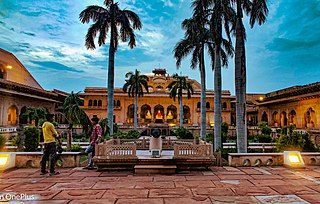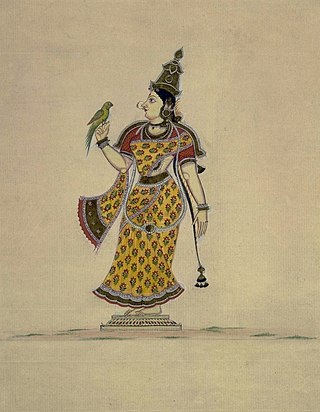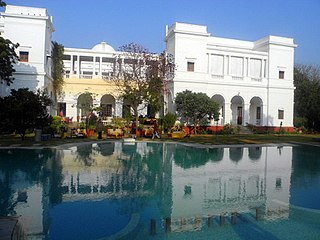
Jaipur, formerly known as Jeypore, is the capital and the largest city of the Indian state of Rajasthan. As of 2011, the city has a population of 3.1 million, making it the tenth most populous city in the country. Located 268 km from the national capital New Delhi, Jaipur is also known as the Pink City due to the dominant color scheme of its buildings.

Agra is a city on the banks of the Yamuna river in the Indian state of Uttar Pradesh, about 230 kilometres (140 mi) south-east of the national capital Delhi and 330 km west of the state capital Lucknow. With a population of roughly 1.6 million, Agra is the fourth-most populous city in Uttar Pradesh and twenty-third most populous city in India.

Rock candy or sugar candy, also called rock sugar, or crystal sugar, is a type of confection composed of relatively large sugar crystals. This candy is formed by allowing a supersaturated solution of sugar and water to crystallize onto a surface suitable for crystal nucleation, such as a string, stick, or plain granulated sugar. Heating the water before adding the sugar allows more sugar to dissolve thus producing larger crystals. Crystals form after six to seven days. Food coloring may be added to the mixture to produce colored candy.

Motilal Nehru was an Indian lawyer, activist, and politician affiliated with the Indian National Congress. He served as the Congress President twice, from 1919 to 1920 and from 1928 to 1929. He was a patriarch of the Nehru-Gandhi family and the father of Jawaharlal Nehru, India's first Prime Minister.

Sawai Jai Singh II popularly known as Sawai Raja Jai Singh was the 29th Kachwaha Rajput ruler of the Kingdom of Amber, who later founded the fortified city of Jaipur and made it his capital.He became the ruler of Amber at the age of 11 after the death of his father, Mirza Raja Bishan Singh on 31 December 1699.

Bharatpur is a city in the Indian state of Rajasthan, 180 km (110 mi) south of India's capital, New Delhi, 178 km (111 mi) from Rajasthan's capital Jaipur, 55 km (34 mi) west of Agra of Uttar Pradesh and 38 km (24 mi) from Mathura of Uttar Pradesh. It is the administrative headquarters of Bharatpur District and the headquarters of Bharatpur Division of Rajasthan State. Bharatpur is part of National Capital Region of India. The city was the capital of the Bharatpur State. It became a municipal corporation with 65 wards in 2014.

Meenakshi is a Hindu goddess. She is the tutelary deity of Madurai and is considered an avatar of the goddess Parvati. She is the divine consort of Sundareśvarar, a form of Shiva. She finds mention in literature as the queen of the ancient Madurai-based Pandya kingdom, and is later deified. The goddess is also extolled by Adi Shankara as Shri Vidya.

The Kachhwaha, or Kachhawa is a Rajput clan found primarily in India.

Stepwells are wells, cisterns or ponds with a long corridor of steps that descend to the water level. Stepwells played a significant role in defining subterranean architecture in western India from 7th to 19th century. Some stepwells are multi-storeyed and can be accessed by a Persian wheel which is pulled by a bull to bring water to the first or second floor. They are most common in western India and are also found in the other more arid regions of the Indian subcontinent, extending into Pakistan. The construction of stepwells is mainly utilitarian, though they may include embellishments of architectural significance, and be temple tanks.

Samode Palace, Samode Haveli and Samode Bagh (Garden) are heritage monuments and structures built by the noble feudatory with the hereditary title of 'Maha Rawal' or 'Maha Saheb’ of the Amber and Jaipur principality in Rajasthan, India. All three have rich history of several hundred years and display a fusion of Mughal and Rajasthani art and architecture. They are now part of the Heritage group of hotels under the flagship name of "Samode" that are run by the hereditary owners of these structures. The Samode Palace is located 40 kilometres (25 mi) north of Jaipur city, the Samode Haveli is close to Jaipur (centrally located within city limits, 6 kilometres (3.7 mi) away from the city railway station) and the Samode Bagh or Garden, 4 kilometres (2.5 mi) from the palace which is also run as a luxury hotel.

Sir Spencer Harcourt Butler was an officer of the Indian Civil Service who was the leading British official in Burma for much of his career, serving as Lieutenant-Governor and later Governor of Burma (1923–27).
The Jaipur-Atrauli Gharana is an Hindustani music apprenticeship fraternity (gharana), founded by Alladiya Khan in the late-19th century. Evolved from the dhrupad tradition, but known for khayal, this gharana is known for producing acclaimed musicians like Kesarbai Kerkar, Laxmibai Jadhav, Mogubai Kurdikar, Mallikarjun Mansur, Shruti Sadolikar, Dhondutai Kulkarni, Pandit Mrityunjaya Agadi Consequently, this gharana developed a reputation for its distinctive vocal aesthetics, raga repertoire, and technical aptitude.

The Pataudi Palace, also called Ibrahim Kothi, is a palace of the former ruling family Pataudi family in Pataudi town of Gurgaon district in Haryana state of India. Passed from the last ruling nawab, Iftikhar Ali Khan, to his son, the last recognized titular nawab, Mansoor Ali Khan, the palace is currently held by his son Saif Ali Khan, who is the current patriarch of the Pataudi family.
Ramchandra Purushottam Marathe, also known as Pandit Ram Marathe, was a Marathi music director, singer, and actor on stage and in films. As a child actor, he performed the title role of Krishna in Prabhat Film Company's 1938 film, Gopal Krishna. He was disciple of Vilayat Hussain Khan, the maestro of Agra gharana of Hindustani classical music., Master Krishnarao Phulambrikar and others. Through Master krishnarao, he developed his Khayal style which had elements of different gharanas such as Jaipur, Gwalior and Agra.
Tantra, or tantric massage, are two defined massages developed in Berlin in 1977. The word Tantra refers to an esoteric yogic tradition that developed in India from the middle of the 1st millennium CE onwards. Erotic massage which incorporates elements from the neotantric movement in the Western world massages the primary erogenous zones of the body, those being the mouth, the phallus (penis), the vagina and the anus.
The Battle of Chausa was a notable military engagement between the Mughal Emperor, Humayun, and the Afghan warlord, Sher Shah Suri. It was fought on 26 June 1539 at Chausa, 10 miles southwest of Buxar in modern-day Bihar, India. Sher Shah Suri was assisted by his allies, the Ujjainiya Rajputs of Bhojpur and Gautam Rajputs who were led by the commander, Gajpati Ujjainia. Humayun escaped from the battlefield to save his life. Sher Shah was victorious and crowned himself Farīd al-Dīn Shēr Shāh.
Ram Nath is an Indian historian who specializes in Mughal architecture. He obtained a doctorate from the Agra University, and later taught at the University of Rajasthan. He is regarded as one of India's leading art historians.
The Atrauli Gharana is a Hindustani music apprenticeship fraternity, founded by four brothers from the Gauharbani tradition who moved to Atrauli from Gwalior in the late-18th century. The gharana is best known for its influence and association with the Jaipur-Atrauli and Agra gharanas.
Sultan-un-Nissa Begum was a Mughal princess, the eldest child and first daughter of Mughal Emperor Jahangir from his first wife, Shah Begum.











